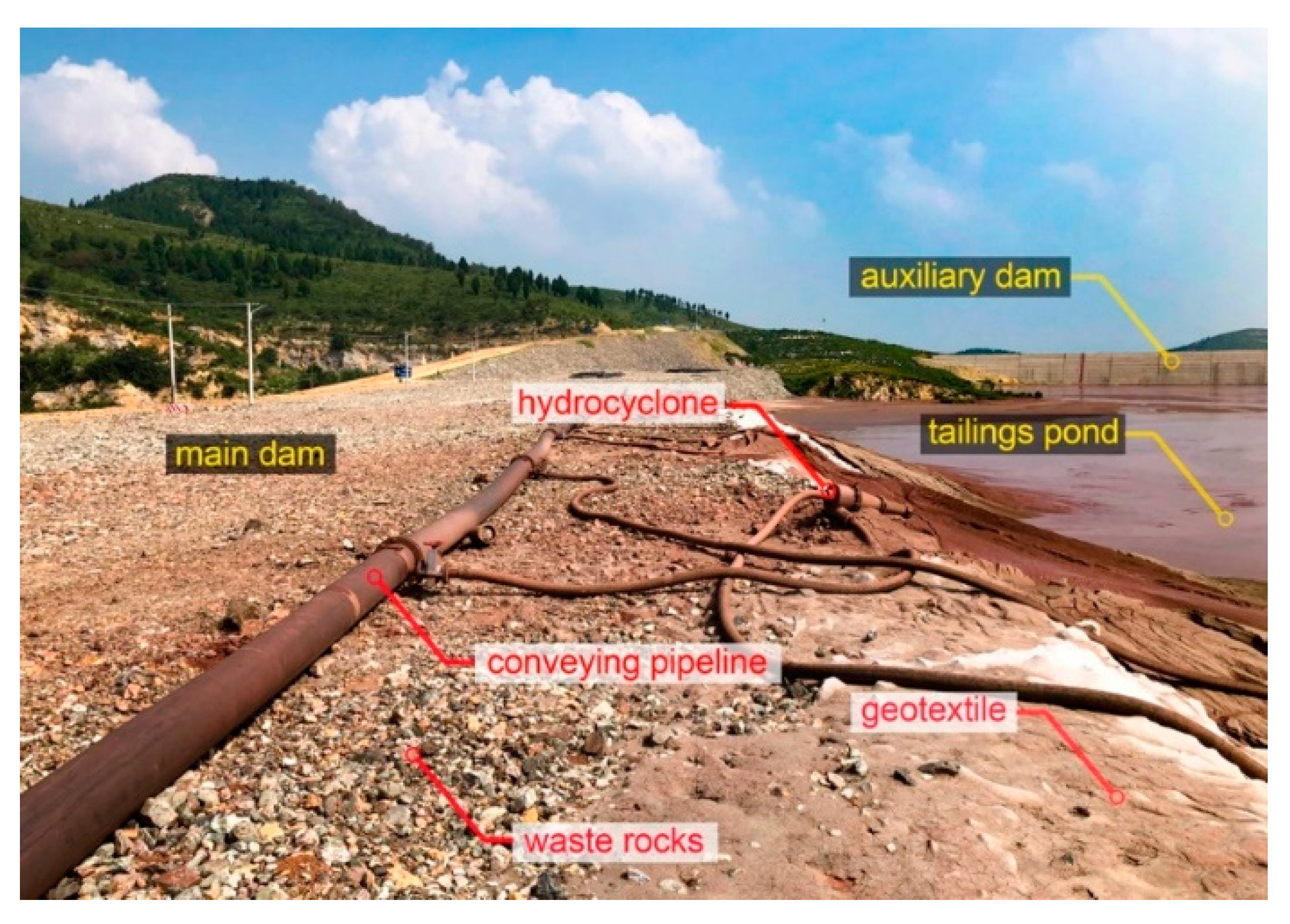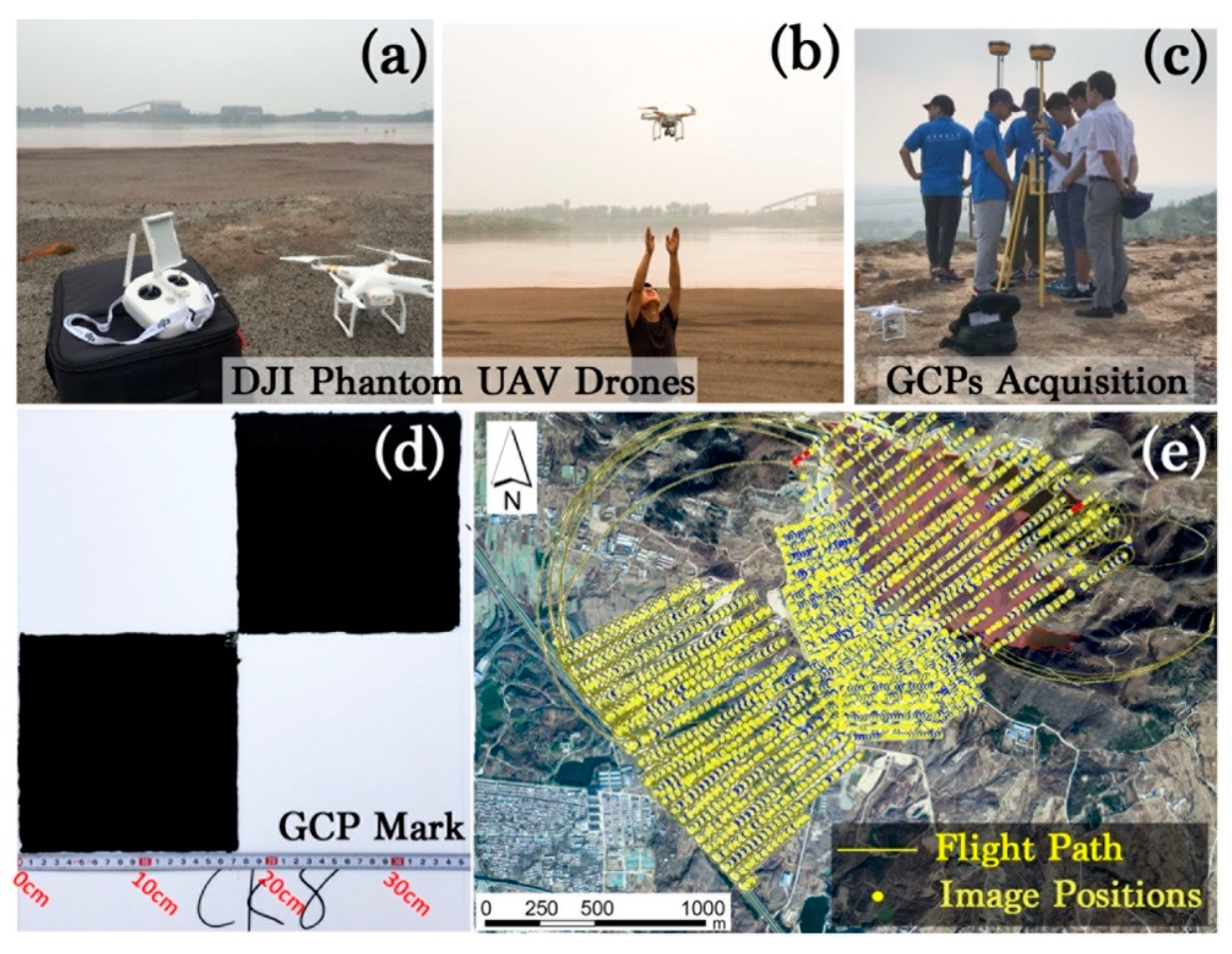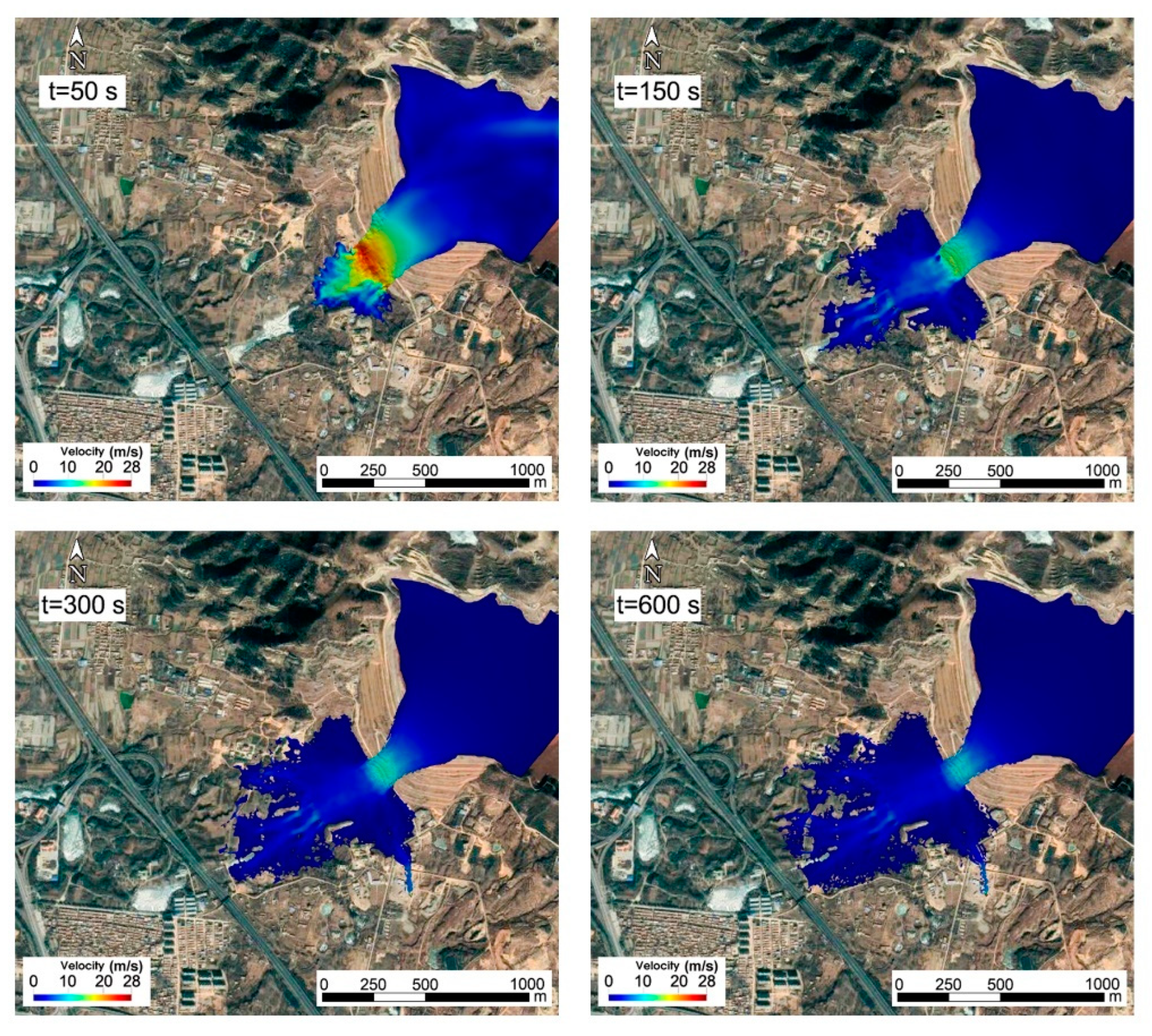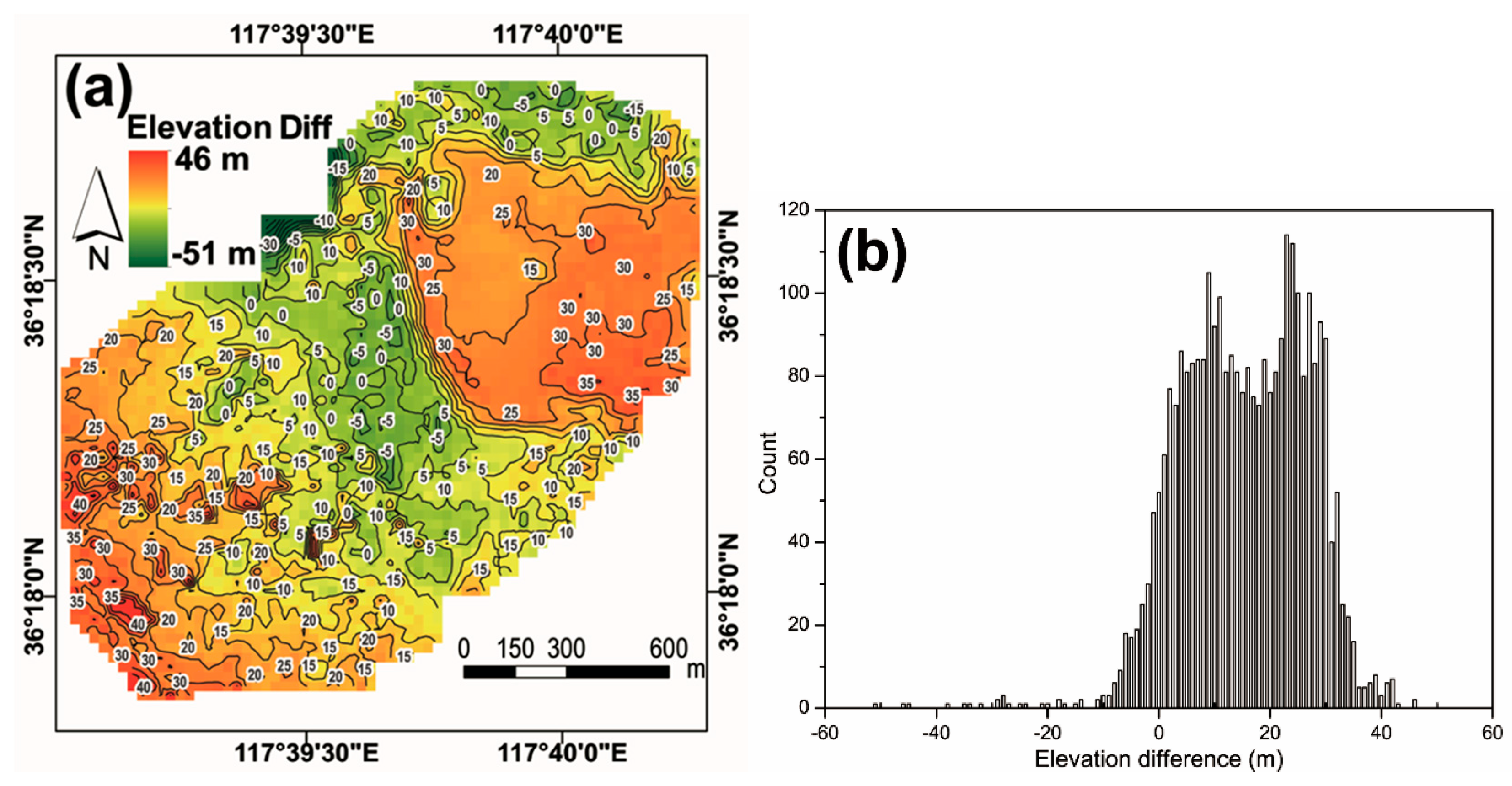3D Numerical Modelling of Tailings Dam Breach Run Out Flow over Complex Terrain: A Multidisciplinary Procedure
Abstract
1. Introduction
2. Materials and Methods
2.1. Study Area and Proposed Procedure
2.2. UAVs SfM-Photogrammetry and Field Surveys
2.3. Smoothed Particle Hydrodynamics (SPH) Method
3. Results
3.1. UAV SfM Photogrammetry
3.2. Tailings Dam Breach Overland Flow
4. Discussion
4.1. Quality of the SfM Photogrammetry Results
4.2. Comparison with Spaceborne DSM Product
4.3. Discussion of the SPH Numerical Results
4.4. Significance of the Study
5. Conclusions and Future Work
- UAV photogrammetry is an advanced and powerful surveying technique in terms of great timeliness, repeatable process, high resolution, flexible schedule, and reasonable costs, when compared with spaceborne remote sensing. It has broad application scenarios in the mining industry, especially for the numerous small-scale mining sites worldwide, where professional surveillance equipment and topographical surveys are not affordable.
- The proposed procedure is presented and successfully applied in a case study in Shandong Province, China. The flow peak velocity of 22.6 m/s was identified at its dam toe at 50 s and a fan-shaped submerged area was formed at 600 s. The safety of the factory plants and workers deployed between the dam toe and the G2 highway was suggested to be primarily concerned.
- The proposed procedure is recommended for the risk assessment of the TSFs. The foreknowledge of the ROOF key features such as the peak velocity and submerged area is critical for the stakeholders to mitigate possible consequences and ensure that catastrophic accidents will not occur.
Author Contributions
Funding
Acknowledgments
Conflicts of Interest
References
- Lottermoser, B.G. Mine Wastes: Characterization, Treatment and Environmental Impacts, 3rd ed.; Springer: Berlin/Heidelberg, Germany, 2010; 400 p. [Google Scholar]
- Azam, S.; Li, Q. Tailings dam failures: A review of the last one hundred years. Geotech. News 2010, 28, 50–54. [Google Scholar]
- ICOLD; UNEP. Tailings Dams-Risk of Dangerous Occurrences, Lessons Learnt From Practical Experiences (Bulletin 121); International Commission on Large Dams: Paris, France, 2001. [Google Scholar]
- WISE Uranium Project. Chronology of Major Tailings Dam Failures (From 1960). Available online: https://www.wise-uranium.org/mdaf.html (accessed on 6 April 2020).
- Bowker, L.N.; Chambers, D.M. The Risk, Public Liability, & Economics of Tailings Storage Facility Failures; Earthworks: Stonington, ME, USA, 2015. [Google Scholar]
- Huang, Y.; Dai, Z. Large deformation and failure simulations for geo-disasters using smoothed particle hydrodynamics method. Eng. Geol. 2014, 168, 86–97. [Google Scholar] [CrossRef]
- Lucy, L.B. A numerical approach to the testing of the fission hypothesis. Astron. J. 1977, 82, 1013–1024. [Google Scholar] [CrossRef]
- Gingold, R.A.; Monaghan, J.J. Smoothed particle hydrodynamics: Theory and application to non-spherical stars. Mon. Not. R. Astron. Soc. 1977, 181, 375–389. [Google Scholar] [CrossRef]
- Shadloo, M.; Oger, G.; Le Touzé, D. Smoothed particle hydrodynamics method for fluid flows, towards industrial applications: Motivations, current state, and challenges. Comp. Fluids 2016, 136, 11–34. [Google Scholar] [CrossRef]
- Huang, Y.; Zhang, W.; Xu, Q.; Xie, P.; Hao, L. Run-out analysis of flow-like landslides triggered by the Ms 8.0 2008 Wenchuan earthquake using smoothed particle hydrodynamics. Landslides 2012, 9, 275–283. [Google Scholar] [CrossRef]
- Pastor, M.; Blanc, T.; Haddad, B.; Petrone, S.; Sanchez Morles, M.; Drempetic, V.; Issler, D.; Crosta, G.B.; Cascini, L.; Sorbino, G.; et al. Application of a SPH depth-integrated model to landslide run-out analysis. Landslides 2014, 11, 793–812. [Google Scholar] [CrossRef]
- Vacondio, R.; Mignosa, P.; Pagani, S. 3D SPH numerical simulation of the wave generated by the Vajont rockslide. Adv. Water Resour. 2013, 59, 146–156. [Google Scholar] [CrossRef]
- Manenti, S.; Wang, D.; Dominguez, J.M.; Li, S.; Amicarelli, A.; Albano, R. SPH Modeling of Water-Related Natural Hazards. Water 2019, 11, 1875. [Google Scholar] [CrossRef]
- McDougall, S.; Hungr, O. A model for the analysis of rapid landslide motion across three-dimensional terrain. Can. Geotech. J. 2004, 41, 1084–1097. [Google Scholar] [CrossRef]
- Wang, K.; Yang, P.; Hudson-Edwards, K.; Lyu, W.; Yang, C.; Jing, X. Integration of DSM and SPH to Model Tailings Dam Failure Run-Out Slurry Routing Across 3D Real Terrain. Water 2018, 10, 1087. [Google Scholar] [CrossRef]
- Pajares, G. Overview and current status of remote sensing applications based on unmanned aerial vehicles (UAVs). Photogramm. Eng. Remote Sens. 2015, 81, 281–329. [Google Scholar] [CrossRef]
- Colomina, I.; Molina, P. Unmanned aerial systems for photogrammetry and remote sensing: A review. ISPRS J. Photogramm. Remote Sens. 2014, 92, 79–97. [Google Scholar] [CrossRef]
- Peternel, T.; Kumelj, Š.; Oštir, K.; Komac, M. Monitoring the Potoška planina landslide (NW Slovenia) using UAV photogrammetry and tachymetric measurements. Landslides 2016, 14, 395–406. [Google Scholar] [CrossRef]
- Gasperini, D.; Allemand, P.; Delacourt, C.; Grandjean, P. Potential and limitation of UAV for monitoring subsidence in municipal landfills. Int. J. Environ. Technol. Manag. 2014, 17, 1–13. [Google Scholar] [CrossRef]
- Lucieer, A.; De Jong, S.M.; Turner, D. Mapping landslide displacements using Structure from Motion (SfM) and image correlation of multi-temporal UAV photography. Prog. Phys. Geogr. 2014, 38, 97–116. [Google Scholar] [CrossRef]
- Westoby, M.J.; Brasington, J.; Glasser, N.F.; Hambrey, M.J.; Reynolds, J. ‘Structure-from-Motion’photogrammetry: A low-cost, effective tool for geoscience applications. Geomorphology 2012, 179, 300–314. [Google Scholar] [CrossRef]
- Rauhala, A.; Tuomela, A.; Davids, C.; Rossi, P.M. UAV Remote Sensing Surveillance of a Mine Tailings Impoundment in Sub-Arctic Conditions. Remote Sens. 2017, 9, 1318. [Google Scholar] [CrossRef]
- Barreiro, A.; Dominguez, J.M.; AJ, C.C.; Gonzalez-Jorge, H.; Roca, D.; Gomez-Gesteira, M. Integration of UAV photogrammetry and SPH modelling of fluids to study runoff on real terrains. PLoS ONE 2014, 9, e111031. [Google Scholar] [CrossRef]
- Wendland, H. Piecewise polynomial, positive definite and compactly supported radial functions of minimal degree. Adv. Comput. Math. 1995, 4, 389–396. [Google Scholar] [CrossRef]
- Monaghan, J.J. Simulating free surface flows with SPH. J. Comput. Phys. 1994, 110, 399–406. [Google Scholar] [CrossRef]
- Fundão Tailings Dam Review Panel. Report on the Immediate Causes of the Failure of the Fundão Dam. Available online: http://fundaoinvestigation.com/the-panel-report/ (accessed on 1 October 2017).
- Jing, X.; Yin, G.; Wei, Z.; Zhang, Q.; Wang, M. Study of tailings dam-break surges with floating slurry in model experiment in different collapse gates. Rock Soil Mech. 2012, 33, 745–752. (In Chinese) [Google Scholar]
- Mahdi, A.; Shakibaeinia, A.; Dibike, Y.B. Numerical modelling of oil-sands tailings dam breach runout and overland flow. Sci. Total Environ. 2020, 703, 10. [Google Scholar] [CrossRef]
- Yu, D.Y.; Tang, L.Y.; Chen, C.C. Three-dimensional numerical simulation of mud flow from a tailing dam failure across complex terrain. Nat. Hazards Earth Syst. Sci. 2020, 20, 727–741. [Google Scholar] [CrossRef]
- Han, Z.; Su, B.; Li, Y.G.; Wang, W.; Wang, W.D.; Huang, J.L.; Chen, G.Q. Numerical simulation of debris-flow behavior based on the SPH method incorporating the Herschel-Bulkley-Papanastasiou rheology model. Eng. Geol. 2019, 255, 26–36. [Google Scholar] [CrossRef]
- Papanastasiou, T.C. Flows of Materials with Yield. J. Rheol. 1987, 31, 385. [Google Scholar] [CrossRef]
- Fourtakas, G.; Rogers, B.D. Modelling multi-phase liquid-sediment scour and resuspension induced by rapid flows using Smoothed Particle Hydrodynamics (SPH) accelerated with a Graphics Processing Unit (GPU). Adv. Water Resour. 2016, 92, 186–199. [Google Scholar] [CrossRef]
- Molteni, D.; Colagrossi, A. A simple procedure to improve the pressure evaluation in hydrodynamic context using the SPH. Comput. Phys. Commun. 2009, 180, 861–872. [Google Scholar] [CrossRef]
- Crespo, A.J.C.; Domínguez, J.M.; Rogers, B.D.; Gómez-Gesteira, M.; Longshaw, S.; Canelas, R.; Vacondio, R.; Barreiro, A.; García-Feal, O. DualSPHysics: Open-source parallel CFD solver based on Smoothed Particle Hydrodynamics (SPH). Comput. Phys. Commun. 2015, 187, 204–216. [Google Scholar] [CrossRef]
- Trieste, D.J. Downstream Hazard Classification Guidelines; US Department of the Interior, Bureau of Reclamation: Washington, DC, USA, 1988.
- Singh, V.P.; Scarlatos, P.D. Analysis of gradual earth-dam failure. J. Hydraul. Eng. 1988, 114, 21–42. [Google Scholar] [CrossRef]
- Tadono, T.; Nagai, H.; Ishida, H.; Oda, F.; Naito, S.; Minakawa, K.; Iwamoto, H. Generation of the 30 M-Mesh Global Digital Surface Model by Alos Prism. Int. Arch. Photogramm. Remote Sens. Spatial Inf. Sci. 2016, 41, 157–162. [Google Scholar] [CrossRef]








| Date | Images | Flight Height (m) | Area (km2) | Frontal Overlap (%) | Side Overlap (%) | Ground Control Points (GCPs) |
|---|---|---|---|---|---|---|
| 1 August 2018 | 3002 | 100 | 2.28 | >75 | >60 | 33 |
© 2020 by the authors. Licensee MDPI, Basel, Switzerland. This article is an open access article distributed under the terms and conditions of the Creative Commons Attribution (CC BY) license (http://creativecommons.org/licenses/by/4.0/).
Share and Cite
Wang, K.; Yang, P.; Yu, G.; Yang, C.; Zhu, L. 3D Numerical Modelling of Tailings Dam Breach Run Out Flow over Complex Terrain: A Multidisciplinary Procedure. Water 2020, 12, 2538. https://doi.org/10.3390/w12092538
Wang K, Yang P, Yu G, Yang C, Zhu L. 3D Numerical Modelling of Tailings Dam Breach Run Out Flow over Complex Terrain: A Multidisciplinary Procedure. Water. 2020; 12(9):2538. https://doi.org/10.3390/w12092538
Chicago/Turabian StyleWang, Kun, Peng Yang, Guangming Yu, Chao Yang, and Liyi Zhu. 2020. "3D Numerical Modelling of Tailings Dam Breach Run Out Flow over Complex Terrain: A Multidisciplinary Procedure" Water 12, no. 9: 2538. https://doi.org/10.3390/w12092538
APA StyleWang, K., Yang, P., Yu, G., Yang, C., & Zhu, L. (2020). 3D Numerical Modelling of Tailings Dam Breach Run Out Flow over Complex Terrain: A Multidisciplinary Procedure. Water, 12(9), 2538. https://doi.org/10.3390/w12092538






